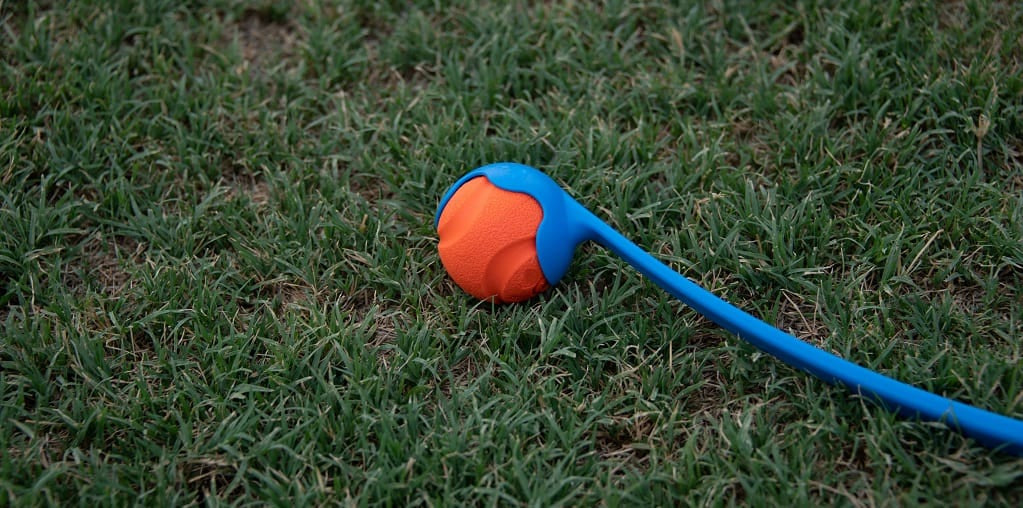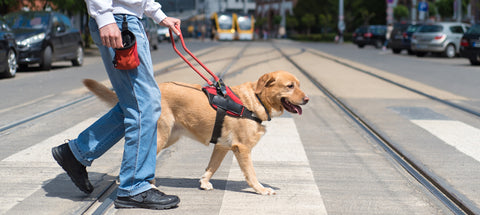Ball throwers are an amazing invention, aren’t they? With a long flexible handle and an ice-cream style scoop that grips onto a tennis ball, they make exercising your dog super easy...
You don't have to bend down to pick up the ball time after time and don’t have to risk putting your shoulder out with the effort of repeatedly throwing a ball for your dog.
You chuck the ball off into the far distance. The dog speeds off after it, races back and drops it at your feet. You scoop up the ball and fling it away again. Rinse and repeat.
What could be easier?
It’s all so easy. To be honest, you could go to the park, sit down on a bench and happily throw the ball to your pup forever, catching up on your emails between flings.
A ball flinger can throw a tennis ball up to 140 feet – around two or three times further than the average non-bionic human can manage.
The ball thrower backlash
However, there’s a growing sense of unease about the dangers of ball throwers for dogs. Sure, they make it ridiculously easy for your dog to clock up their daily exercise quota. But are they actually good for your furry best friend?
Turning a stroll into a high-intensity workout
If you watch your dog out on their everyday walk, they’ll be stopping to sniff interesting bits of grass, meandering around, and generally bumbling along and enjoying the company, the fresh air and the environment.
When we repeatedly fling a high-speed ball for them to catch, we’re transforming that pleasant amble into a continuous HIIT session.
Obsessed with balls
The problem is that dogs just love chasing balls. It feeds into their ancient instinctive drive to hunt down small animals. And although you regularly give them delicious food and they don’t have to catch their own dinner any more, some of that instinct remains. So when they see a ball, an ancient part of their brain thinks “Rabbit!” and they speed off to track it down, hyped up on the thrill of the chase.
Wear on your dog’s joints
When your dog repeatedly dashes after a ball, they’re racing from a standing start to 100mph, screeching to a halt and often jumping up in the air too. This can put an extra strain on your pup’s joints, muscles and cartilage.
Interestingly, braking can cause the most potential damage, as this is the moment when your dog’s weight is flung forward onto their shoulders.
The burden on the joints is increased if your dog is tearing up and down hills, or is running on a sandy beach, which takes much more effort than running on grass or a woodland path.
And because your dog is excited about chasing after a rabbit disguised as a ball, that enthusiasm can easily lead to them over-riding any warning signals their body is giving them to slow down.
The result? Wear and tear on your dog’s joints that can lead to stiffness and stop them from enjoying their life to the full.
What’s the alternative?
It looks as though the days of the ball flinger are numbered. They might mean that we can exercise our dog while hardly moving a muscle ourselves, but the evidence is growing that they’re just not very good for our four-pawed friends.
However, you can say goodbye to the ball thrower and still have fun exercising with your dog.
Hide and seek

A great alternative to the ball flinger is a game of hide and seek. Take your dog’s much-loved ball, hide it and ask them to sniff it out. This has the advantage of engaging your dog’s brain as well as their highly developed sense of smell.
Return to the classic game of fetch
Try a game of fetch, played the old-fashioned way, to give your dog all the joy of chasing a ball but at a less intense pace and without the high-speed manoeuvres.
Unless you’re a javelin world champ, it’s unlikely the ball will travel anywhere near as far as it would with a ball flinger. Plus, you get the benefits of being more engaged with your pup.
However, it’s still probably better to limit the game to around five throws so your dog doesn’t become obsessed.

A word of warming
You can also help protect your dog’s joints by making sure that they warm up before you throw that ball across the nearest field. In the same way that you’d stretch your limbs before going for a run, give your dog a chance to ease their muscles before they sprint after a ball. Five to ten minutes of walking should do the trick.
That way, your furry best friend will be primed and ready for the game, with their heart rate slightly elevated and their muscles gently stretched.
What do you think?
How about you? Do you love or hate ball flingers? And do you have any brilliant ideas for alternative ways to engage your pup on their walks? Please share your photos and thoughts with us on Facebook and Instagram.










